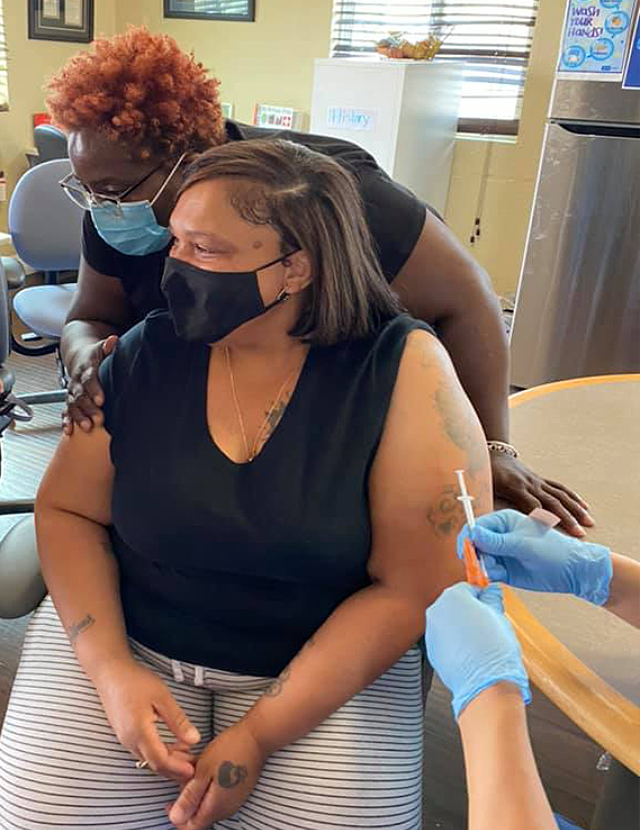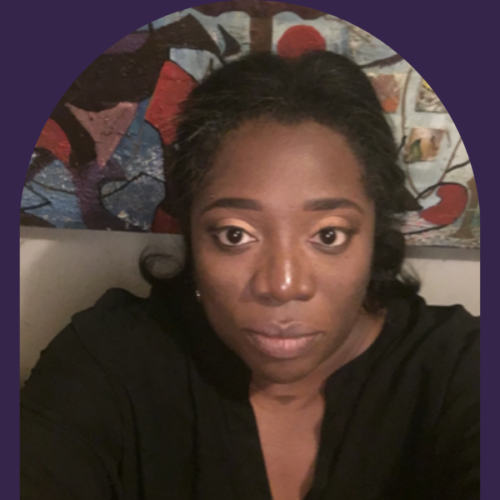The Importance of Shifting Narratives, Supporting Black Communities Devastated by COVID
Program
Highlights

With funding from PHI's Communities RISE, Chromatic Black developed a ‘Keep Black Love Alive’ campaign that addresses undermining beliefs fueling medical distrust in the Black community, vaccine hesitancy and misinformation around COVID through sharing stories.
5K advocates activated
500 stories collected
65 neighborhoods visited
-
Focus Areas
Chronic Disease Prevention -
Issues
Population Health -
Expertise
Outreach & Dissemination -
Strategic Initiatives
COVID-19
Shifting the narrative is central to the futurist artist-activist collective Chromatic Black. The group’s mission is to “disrupt the master narrative with good storytelling.” The master narrative is defined by author Toni Morrison (in a 1990 conversation with Bill Moyers) as “whatever ideological script that is being imposed by the people in authority on everybody else.”
As narrative strategists, Chromatic Black sought to address undermining beliefs fueling medical distrust, vaccine hesitancy, and misinformation around COVID by collecting and sharing stories through a campaign called Keep Black Love Alive. The campaign focused on the rural South and included a listening tour and unique experiences beyond the standard “hot dog and DJ” event.
When COVID hit, Chromatic Black shifted from conversations they had already had about the fragile public health infrastructure before the pandemic to focusing on supporting communities, especially around the rollout of vaccines. Chromatic Black thought a civic model was the right approach to address vaccine hesitancy. Based on their previous work with community organizing groups, they knew their ability to mobilize on the ground and serve as trusted advisers. The Public Health Institute’s Communities RISE funding allowed them to test this theory along with innovative outreach approaches.
In addition to food dissemination and fine and fee clinics where individuals could get assistance clearing balances that were “jamming them up,” the campaign also tapped into Chromatic Black’s roots in the arts by making films about what it means to be in the community, and photo essays about people’s experiences with COVID. Following quarantines that kept lots of folks cooped up indoors, the campaign also incorporated outdoor sports and play into their events, including double dutch contests and kickball. The campaign visited 65 neighborhoods, collected 500 stories, and activated 5,000 advocates.
These events also included information about COVID vaccines and mobile vaccine clinics whenever possible. But the campaign positioned itself as “Switzerland,” a neutral voice providing information but not pushing people to get vaccinated.

We are aware of the many ways in which the public health system has failed black folks and poor folks in this country. The medical experimentation that profits off of Black and Brown bodies and poor bodies are not confined to the turn of the century. It's something that is occurring today. So we wanted to validate the fears and concerns of Black folks so that it doesn't re-victimize us and that there isn't a dissonance from what occurs.Abene Bloodworth
Chromatic Black co-founder and one of the chief architects of the Keep Black Love Alive campaign
“We are aware of the many ways in which the public health system has failed black folks and poor folks in this country,” explains Abene Bloodworth, Chromatic Black co-founder and one of the chief architects of the Keep Black Love Alive campaign. “The medical experimentation that profits off of Black and Brown bodies and poor bodies are not confined to the turn of the century. It’s something that is occurring today. So we wanted to validate the fears and concerns of Black folks so that it doesn’t re-victimize us and that there isn’t a dissonance from what occurs.”
A powerful example of this fear came from a woman in her eighties named Jamila. According to Abene, Jamila “had absolute confidence and trust in the vaccine and the system. And she mobilized everybody within her tribe. She got, like, 30 people to go to get vaccinated. So everybody went ahead of her and got vaccinated, and then when it was her time, she completely flipped out.” As the doctor approached her with the vaccine, Jamila said she saw all her ancestors and started to weep and shake uncontrollably. She was embarrassed and told the doctor she didn’t understand why she was suddenly afraid to receive the vaccine.
The doctor, a White man, was patient and understanding, acknowledging the long history of Black mistreatment by the medical system. He told Jamila to take her time and wait until she was ready, and she stayed at the event for several hours. When things started to close down, she was still there, and the doctor came back to check on her. Jamila asked if he would sit and pray with her, and he did. The prayer brought Jamila peace and calm; afterward, she was ready to receive her vaccine.
Generational trauma wasn’t the only deterrent to COVID vaccinations in the communities where the Keep Black Love Alive campaign was active. Access was a huge issue for a variety of reasons. For example, says Harmon, “In Albany, Georgia, the local public health infrastructure was decimated. One large health system called Phoebe bought up all these small clinics and absorbed them into these big hospitals. And, you know, the closest hospital is 50 miles away.” Access was an issue even in more urban areas, especially during severe weather. Torrential rains, tornadoes, and snow can prevent people from traveling to get a vaccine.
This is why Keep Black Love Alive tried to incorporate mobile vaccine clinics into their events whenever possible. Says Harmon, “We would either set up situations where you could get vaccinated or get information on-site with, or we’d give you information as to where you could go.”
The Keep Black Love Alive campaign has now moved into its second phase, armed with a multitude of stories and oral histories reflecting the Black experience of COVID. In June 2022, they brought together 50 movement leaders from across the country in person, along with Harriet Washington, author of Medical Apartheid, Dr. Valerie Montgomery Rice, President and CEO of Morehouse College’s School of Medicine, and Jewell Jackson McCabe, founding president of the National Coalition of 100 Black Women.
The gathering (which will be followed by an even larger virtual event) will focus on what has been learned during the pandemic, the structural roots of health inequity, what a “well world” might look like, and, critically, the policies needed to get there. The conversation will inform a presentation to the Congressional Black Caucus in November 2022. “We’re really excited about that,” says Bloodworth. “And it’s all the work that’s been done for the past year, including being a part of RISE, that has gotten us to this place, to be able to have that conversation.”
Communities RISE Together supports COVID vaccination efforts in African-American, Asian-American/Pacific-Islander, Latinx, Native-American, rural, immigrant/migrant and low-income, older adult populations. Communities RISE Together works on the ground in more than 220 counties in 27 states in communities with low vaccination rates by calling on the capacity of 2,400 community-based organizations who have reached over 100 million people across the nation. The initiative is a collaboration between WE in the World, the Well Being in the Nation (WIN) Network and Public Health Institute.
A version of this impact story first appeared in a Communities RISE newsletter.
Work With Us
You change the world. We do the rest. Explore fiscal sponsorship at PHI.
Support Us
Together, we can accelerate our response to public health’s most critical issues.
Find Employment
Begin your career at the Public Health Institute.
